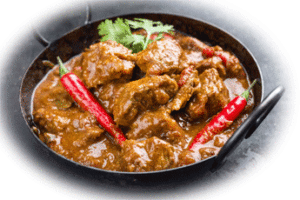
In South Africa, be it at a Shisa Nyama, home braai ( barbeque), eating a Bunny Chow in Durban or watching the rugby, you will find Chillies somewhere. Eating food with Chillies is part of what it means to be South African. But, how just did Chillies get to where they are?
SOUTH AFRICAN COOKING
A TASTE OF AFRICA
 The bigger picture
The bigger picture
South Africa is a country with a diverse cuisine. This is a cuisine that has been shaped by many influences. These influences have all played their part in making South Africa cuisine what it is today.
In dishes like Babotie, Sosaties and Ingelegde vis (pickled fish) you will find the influence of Malaysia and Indonesia.
Biltong , Boerewors (a spicy South African sausage) and Potjiekos are foods that came from the Netherlands. The original recipes were however quite different from what they are today. Their spicing was adapted to local tastes.
that came from the Netherlands. The original recipes were however quite different from what they are today. Their spicing was adapted to local tastes.
The influence of India can be seen in dishes like Samoosas, Bunny Chows and Durban curry. Once again, these were dishes that were adapted to meet local needs. The dishes could not always be made exactly as they were in India. Certain spices were simply unavailable. Thus, recipes were modified to be made with what could be found locally. Chillies would almost certainly have into this category
Combine that with the influence of the Portuguese and African cuisine like Chakalaka & Phutu & Shebaand you have a melting pot of fantastic, interesting food that is simply irresistible! Join us as we explore the history and influences that led to the shaping of this fantastic cuisine.
Dutch and Cape Malay
 The Cape of good hope
The Cape of good hope
The Netherlands colonised South Africa way back in 1652 with the arrival of Jan van Riebeek. He established a settlement in the Cape of Good Hope. Jan van Riebeek and the men accompanying him had been given the task of setting up a supply base for Dutch ships.
It was inevitable that the Dutch would see Malay and Indonesian influences creeping into their menus,as they often had slaves that they brought with them working in their kitchens
Current day classics likeBobotie, Cape Malay curries, Sosaties ( kebabs) and Bredies (stews) soon became part of everyday eating. The kitchen workers often adapted these dishes from the original recipes to make them more palatable to their owners. This may have entailed toning down the heat element, but it still meant that Chillies had arrived as part of South African cuisine. Today, these dishes are considered traditionally South African and an intricate part of the culture.
Another South favourite is a sausage called Boerewors ( farmers sausage) . Boerewors was created when the Dutch adapted Braadworst , a sausage from the Netherlands to local tastes. Spices like coriander, black pepper, cloves and nutmeg were added to the recipe to make Boerewors what it is today. While the original Boerwors recipes did not contain Chillies. Today, Chillies are added to Boerewors to make a spicy versionof the sausage.
The Indian touch
 Port Natal
Port Natal
Indians were brought to South Africa as indentured labourers by the British. They came from a country with a rich heritage in cuisine. They brought their fantastic cuisine with them. you can bet that the one spice they definitely would have brought with them would have been Chillies. At some point, however, they would have needed to rely on what was available locally. This drove change
A combination of local conditions and factors influenced the distinct Indian cooking style found in South Africa today. When the Indian labourers arrived in the country, they often had to substitute local ingredients for those they
 might previously have used in India. They were also introduced to different tastes and cooking methods by their countrymen, who had come from other parts of India. With these factors influencing them, the traditional way of doing things changed. South African Indian cuisine started taking on a shape of its own
might previously have used in India. They were also introduced to different tastes and cooking methods by their countrymen, who had come from other parts of India. With these factors influencing them, the traditional way of doing things changed. South African Indian cuisine started taking on a shape of its own
Anyone who has eaten a Durban curry knows this is excellent eating. When this excellent curry is filled into a half or quarter loaf of hollowed-out bread to become a ” Bunny Chow” – this dish takes on even more greatness. It becomes a takeaway meal with incredible taste and depth of flavour.
How the Bunny Chow received its name is the subject of much debate and speculation. The one thing that is for sure, though, is that Bunny Chows are an iconic South African dish loved by all. Together with South African Breyanis (Indian Biryani), Chilli bites, samoosas (Indian Samosas), it is easy to understand why South African Indian cuisine has come to be as unique and appreciated as it is today.
Portugal
 Peri – Peri Chicken
Peri – Peri Chicken
Many citizens of the former Portuguese colonies of Mozambique and Angola settled in South Africa. Being the great cooks that they are, the Portuguese discovered that the African Birds-Eye (Peri-Peri) Chilli had taken on a character of its own. It had developed more heat and its own distinctive flavour. These unique qualities were put to exceptional use in the creation of their now world-famous Peri-Peri chicken.
Peri-Peri chicken, which is made by marinating spatchcocked chicken in lemon juice, garlic,African devil Chillies & salt. It is then grilled ( braaied) over an open fire.
This great tasting chicken found its way across the border from Mozambique and soon became a South African favourite.
Today, Peri -Peri grilled chicken is virtually ubiquitous in South Africa. Besides being offered by great Portuguese restaurants (including Nandos, of course), you will find Peri-Peri chicken being eaten at many a home-cooked braai ( barbeque).
Other South African favourites from Mozambique are Peri – Peri prawns, Prego rolls. Peri Peri sauce and Portuguese Chili oil. These dishes are so good that they have become an iconic part of cuisine in Portugal as well as in Africa. This is noteworthy, because as general rule the Portuguese people don’t particularly like spicy food !
And the final result.
All of these influences have not gone unnoticed by the other parts of the South African nation. All have had their impact on South African cuisine as a whole. Dishes like Potjiekos with Chilli, offal curry, Chilli Sticks (Biltong with Chilli) and Spicy Droewors ( spicy dried sausage ), all of which are considered typically South African.
The rich and diverse history of South Africa has made the love of the Chilli an undeniable part of being South African. Who would have thought that a spice that started out in Central or South America would find itself so part and parcel of the cuisine and culture in a fantastic country on the tip of Africa? Absolutely amazing.
Image Credit
SunshineSeeds / Depositphotots





